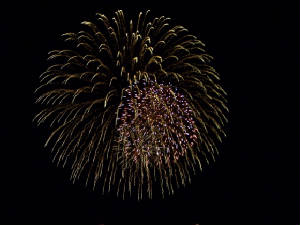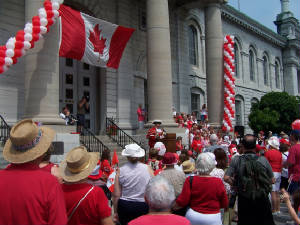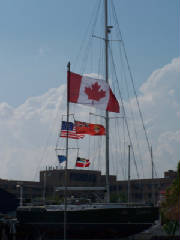|
|
 |
There are two pages to this section. Click the link below to get to the second page.
Click here to go to Page 2 -- a Kingston bonus day and on to Trenton.
|
 |
|

June30-July 2 Happy Canada Day in Kingston!
We arrived a day early, celebrated Canada Day in grand style, and stayed an extra day in Kingston for
good measure. We loved this city!
Here's how we celebrated Canada Day. We began with a big breakfast special at a deli cafe, while reading
all the Globe and Mail articles commemorating the day and ruminating on the state of the country.
Then we took a Trolley Tour to get an overview of the city. We learned that Kingston is known for
three things: the military, its universities, and its penitentiaries.
Because of its strategic location on Lake Ontario at the entrance to the Rideau Canal, Kingston has long
been a strategic military location, with three forts and four round defense towers called martello towers
along the waterfront. The British also had royal shipyards here from 1813 until 1852.
Of both military and university import is the Royal Military College of Canada located
here. It trains officers for all branches of military service. Tuition is free, but five years service post-graduation
is required. Since 1923 the Royal Military College has had a hockey rivalry with another service academy we saw during this
trip -- West Point. Queen's University is also here. Established in 1841, it has 20,000 students.
Finally, with ten penitentiaries in the area, Kingston leads the nation in incarceration.
We wanted to visit the Penitentiary Museum, but never found the time. It is on our must do list for our next trip here.
I had read in a guide book that Kingston is the fresh water diving capital of the world, with over 200 shipwrecks
off her shores. Anticipating cruising off Kingston's shores, I found this information a bit disconcerting. Our
tour guide provided an explanation that offered some solace -- when Britain finally decided that America was no longer a threat, the
British navy sunk a bunch of excess inventory from their royal shipyards, rather than trundle them back across the Atlantic.
So, some of the shipwrecks in the offshore diver's haven were unintentional, but most are just Britain's marine junkyard.

|
| Speeches on the steps of City Hall |
As our trolley tour ended, we noticed a crowd gathering around City Hall, and heard a choir singing Oh
Canada. We joined the crowd of people dressed in red and white, and listened to a few speeches. .An event volunteer
gave us each a little Canadian flag to wave. Across the street from the Town Hall is Confederation Park and the Confederation
Basin Marina -- the central area for the day's festivities. We went to the park to watch a scheduled boat parade, but
less than a dozen boats showed up, due to high winds and white cap waters. The people watching was great, though.
We did a walking tour of town, enjoying the buildings and the festive atmosphere of this breezy day.
People had all manner of red and white and maple leaf attire, red-dyed hair, Canadian flag temporary tattoos and face-paintings.
My personal favorite was a man wearing a pair of Canadian flag shorts with the maple leaf placed like Adam wore his fig
leaf.
Musicians played in the park and on street corners, and the sidewalk cafes were bustling.
In the afternoon we rode our bikes to Bellevue, an Italianate Villa style home where Canada's
first prime minister, John McDonald, lived in 1838-39, long before he became prime minister. The home has been restored,
furnished with period pieces, and is a museum. In celebration of Canada Day, admission was free, and there were lots
of special activities. We sipped freshly squeezed lemonade and ate melt-in-your-mouth shortbread in the garden while
listening to a quartet play classical pieces on recorders. Costumed interpreters strolled the grounds and welcomed us
to the house, where we enjoyed our self-guided tour of the rooms, and learned a little more about McDonald's struggles early
in his political life.
The day ended with fireworks at 10 pm. Starsong's flybridge was the perfect spot to sit and watch
the show. It was a glorious end to a wonderful day!
After you read the special Canada Day section in blue below, you can click her to continue with our adventures in Kingston
and beyond.
|
 |
|
|
 |
|
|
 |
|
|
|
Some facts in honor of Canada Day:
Canada Day as we know it is a surprisingly recent holiday. It was established as Dominion Day
in 1879 to celebrate the tenth anniversary of the union of Britain's North American Provinces into the confederation of Canada.
Dominion Day remained a ceremonial occaison commemorated only in the nation's capital for many years. In 1980,
the government decided to encourage local events in celebration of Dominion Day, and they offered a few grants to provincial
capitals to encourage fireworks and such. In 1982 the name of the holiday was changed to Canada Day, and the government
expanded its sponsorship of local events. Now the holiday is widely celebrated much in the manner of the US's Independence
Day.

The Canadian flag as we know it is also relatively new, dating only to 1965. The search for a new
flag began in 1925. After multiple failed attempts over the years, the Canadians were inspired to make it happen by
1967, their centennial year. The maple leaf has long been a symbol of Canada, and there was agreement about its use
on the flag, but the form it would take -- one leaf or three, background color, and so on -- was cause for endless debate.
Kingston members of the committee, including a dean from the military college, pointed out the attractive format of the college
flag, and they ended up adopting the Royal Military College flag with a maple leaf substituting for the college crest in the
middle section.
Finally, here's a surprise about the Canadian National Anthem -- it was originally written in French for
a French-Canadian National Festival in 1880. The music was by Calixa Lavallee and the music was by Sir Adolphe-Basile
Routhier. It was proclaimed the Canadian national anthem in 1980, the 100 year anniversary of its composition.
Here are the words:
Oh Canada!
Our home and native land!
True patriot love in all thy sons command.
With glowing hearts we see thee rise,
The true North strong and free!
From far and wide, Oh Canada,
We stand on guard for thee.
God keep our land glorious and free!
Oh Canada, we stand on guard for thee!
Oh Canada, we stand on guard for thee!
|
|
|
 |

